
Lighting is one of the most important factors in image quality. As it gets darker, a surveillance camera’s ability to capture evidentiary detail such as faces and licence plates rapidly decreases. In order to overcome this, artificial sources of light can be added to the scene, the most common of which is infrared (IR) illumination.
While the human eye can detect visible light in the ranges of 390 to 750 nanometer (nm), IR light is at a higher wavelength (typically 850 nm), making it invisible to the human eye while providing the camera the ability to ‘see’. Since IR light has a higher wavelength than the colour spectrum, the resulting image will be in monochrome (black and white), but can capture crucial detail in complete darkness.
However, using IR as a source of illumination has a few side effects. For example, the IR illumination must be calibrated to the camera’s field of view to provide the most effective illumination over the entire imaging area and remove unwanted side effects such as hot-spotting and dark edges. This calibration is especially problematic when using a camera with a varifocal lens, as the camera’s field of view changes based on the position of the lens’s focal length. Another challenge of using IR as a source of illumination is that objects that come close to the source quickly become oversaturated and evidentiary detail can be obscured.
Advances in camera technology, notably adaptive IR technology, can help overcome these challenges and improve the quality of the evidence captured in the image. This paper provides an overview of the adaptive IR technologies currently available, their purpose, and their shortcomings.
Adaptive IR technology
There are many cameras in the market, both analogue and IP, that offer integrated IR. ‘Integrated IR’ means that the camera comes equipped with IR Light Emitting Diodes (LEDs) that provide illumination when the camera is placed in very low light environments. However, almost all of these cameras provide only static IR settings, meaning that the camera’s IR settings are set by the manufacturer at the time of production and do not change dynamically based on the camera’s environment; limiting the camera’s ability to provide the best image quality in every condition.
Avigilon’s Adaptive IR technology combines multiple adaptive processes to always deliver the best evidence:
* Zoom Adaptive – Focuses the IR beam to the camera’s field of view, providing the most effective IR illumination at every zoom position.
* Content Adaptive – Optimises camera settings dynamically based on changes in the imaging area to improve the quality of the evidence captured through two methods:
° Oversaturation Detection: Removes oversaturation while reducing motion blur and providing more effective licence plate illumination.
° Ignoring Background Oversaturation: Ignores stationary oversaturated areas to provide the most detail of moving objects, even in the darker regions of the image.
By combining these features, Avigilon’s integrated IR cameras with their patent-pending adaptive technology provide the most effective illumination to capture the best evidence in any surveillance scenario.
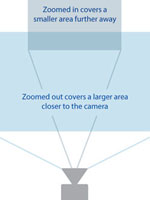
Zoom adaptive
When a camera comes with a varifocal lens, for example a 3-9 mm lens, the user has the ability to change the field of view of the camera, narrowing the size of the area covered as the camera is zoomed in.

As we zoom in, the camera effectively captures an image that covers a smaller area farther away. When using IR light to illuminate the imaging area, a camera with zoom adaptive IR technology will dynamically focus the IR light to the area covered by the camera. As a result, as we zoom in, the IR beam angle is focused along with the lens, to illuminate an area that is smaller but farther away.
Without zoom adaptive technology, the manufacturer sets the camera’s IR illumination to a pre-set beam angle, covering a fixed distance and area, generally somewhere between the two ends of the lens’ focal length.

When IR settings are fixed, the area of IR illumination cannot be changed based on the camera’s field of view. As a result, static IR only provides optimum illumination when the camera is at the same zoom position as the IR illumination area. If the camera’s field of view is wider than the illumination area (the camera is zoomed out further), edges of the imaging area will not be illuminated and important detail can be lost. On the other hand, if the camera’s field of view is narrower than the illumination area (the camera is zoomed in further), IR light is being wasted on areas not captured by the camera. As a result, less light is available for the imaging area. This creates darker, noisier, and less-detailed images.
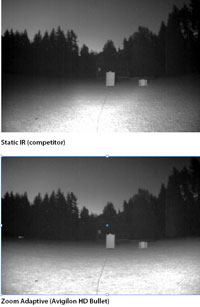
Zoom adaptive IR provides the most effective use of IR illumination, ensuring uniform illumination over the entire imaging area at every zoom position, and eliminating wasted IR by focusing all the available IR to the camera’s imaging area.
Content adaptive
While zoom adaptive technology provides the most effective illumination based on the angle of view of the camera, during operations, the camera’s imaging area can change dramatically. Changes can come from either subjects moving through the scene or from other sources of illumination changing the lighting conditions within the imaging area. Avigilon’s content adaptive technology dynamically adjusts the camera’s settings based on the changes within the imaging area to improve the quality of the evidence captured through the two methods of Oversaturation Detection and Ignoring Background Oversaturation.
Oversaturation detection
At any given time, a camera can ‘see’ objects within a specific range of lighting conditions. Let’s say you have a light source in the corner of the room and three objects at different distances from the light source.
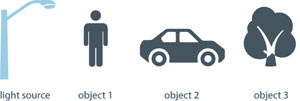
The camera’s automatic mode will set the camera’s settings based on the average scene illumination. The most likely result is that the second object is clearly displayed while the other two objects are either oversaturated or completely dark.
Automatic settings

Some camera features, such as backlight compensation and exposure, allow the user to bias that range towards darker or brighter lighting conditions. For example, the camera’s shortest exposure will likely display the first object clearly but leave the other two objects completely dark.
Shortest exposure

The camera’s longest exposure will likely display the last object clearly but leave the other two objects oversaturated.
Longest exposure

Cameras with Wide Dynamic Range (WDR) can see objects within a larger range of lighting conditions. However, this range is still limited as it clearly displays the first two objects, while still leaving the last object in the dark.
Wide dynamic range

Content adaptive technology adjusts the image brightness to the part of the image that is of most interest (moving objects) by ignoring the parts that are least interesting (stationary oversaturated objects such as street lamps). Since WDR cameras can see a wider range of illumination, a larger portion of objects within the scene will have appropriate brightness and therefore adjusting the image brightness for specific objects will have a smaller effect on the overall picture. On the other hand, cameras without WDR have a much smaller range of illumination and adapting the image brightness for specific objects is likely to result in a much bigger difference in the image. While cameras with a WDR feature will still experience the benefits of Content Adaptive technology, those cameras without a WDR feature will experience a larger benefit in similar lighting conditions.
Achieving the right level of illumination on objects of interest is particularly important when using IR illumination at night or in dark environments. Since the general environment is extremely dark and the source of illumination is extremely bright, oversaturation can happen quickly when objects come closer to the camera and the camera is trying to balance what it can see. As shown in Figure 5, a person entering the scene can rapidly become oversaturated without needing to be close to the camera.
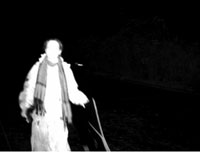
This oversaturation problem is further heightened by the fact that different materials have different light reflectivity properties. For example, licence plates and safety vests have highly reflective coatings that will oversaturate the object and its surroundings. Cameras without content adaptive technology will set the camera’s imaging settings based on the average illumination in the imaging area. Since most of the imaging area is extremely dark, the average will allow important objects to be oversaturated and detail to be missed.
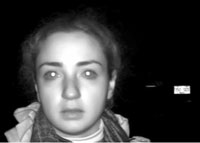
Cameras offering content adaptive IR technology will look intelligently at the relative size of the oversaturated area and will adjust the camera to remove the oversaturation when the area occupied by the object is large enough. This technology effectively prevents objects closer to the camera from becoming oversaturated (since the object occupies a larger area in the image) and ignores oversaturation that is caused by a light source (car lights or street lamps in the background). It is a very effective way of ensuring that the objects you care most about have the right level of illumination and detail.
Content adaptive technology
There are two predominant ways to remove oversaturation, each with its own strengths and side effects. The first way is to decrease the brightness of the IR illumination. Since the object is most likely oversaturated as a result of the camera’s IR illumination, decreasing the IR illumination is an effective way of removing the oversaturation. The second way is to reduce the camera’s exposure. Exposure controls the amount of time that the sensor is exposed to light. Reducing the exposure reduces the amount of light entering the sensor for any given frame, and as a result effectively removes the oversaturation. The important thing to note is that in both of these cases, the overall image will be darker, as in the first case the amount of light illuminating the scene is reduced, and in the second case, the amount of light entering the sensor is reduced. However, since you generally care more about objects closer to the camera rather than background objects, this is a very effective trade-off in the surveillance industry.
Each of these methods of removing oversaturation, namely decreasing IR illumination and reducing the camera’s exposure, has its own advantages. If there are other sources of light brightening the background of your scene, reducing the IR illumination allows the image’s background to remain as bright as afforded by your other light sources. On the other hand, when you reduce exposure, the entire image will be darker, including additional light sources as depicted in Figure 7.
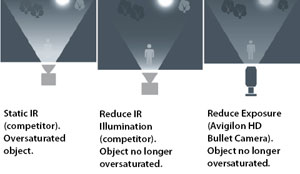
However, there are also a number of advantages to reducing exposure rather than IR illumination. First, high exposure results in blurriness when objects in the scene are moving; therefore, reducing exposure provides sharper images of moving objects within the scene.
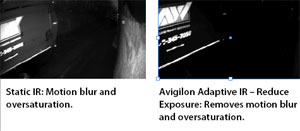
In surveillance, the objects you generally care most about are those that are moving; for example a person entering the scene or a car going through it. Lowering exposure can make a large difference in both of these cases as motion blur can hide facial detail and obscure licence plates.
Another advantage of reducing exposure rather than IR illumination is evident when capturing a licence plate on a car, even if the car is not moving. As shown in Figure 9, a car’s licence plate is located between two headlights that are very bright sources of illumination. However, since that illumination is shining away from the licence plate, the plate itself is not being illuminated.
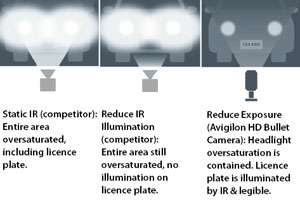
In that scenario, with Static IR, the headlights are so bright that the entire region will be oversaturated and the licence plate will not be legible. Reducing the IR illumination will do nothing to reduce the oversaturation from the headlights but will remove the IR light illuminating the licence plate, further reducing the ability to read it. On the other hand, reducing the exposure will decrease the oversaturation from the headlights away from the licence plate while maintaining the IR illumination on the licence plate. Since most licence plates are extremely light-reflective, reducing the exposure while maintaining the IR illumination will make the licence plate legible.
Avigilon’s content adaptive – oversaturation detection technology smartly reduces exposure based on scene content, removing oversaturation while reducing motion blur and effectively capturing licence plates on moving vehicles in darkness.
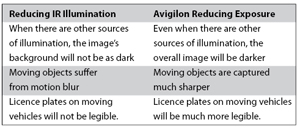
Ignoring background oversaturation
In any surveillance scenario, the objects of interest are the ones that are moving or changing. That is why most surveillance video is recorded on motion. Avigilon’s unique content adaptive technology also ignores fixed oversaturated areas so that the camera can configure itself to best capture the objects that are moving.
Generally, cameras automatically adjust themselves to capture the best image by looking at the overall scene and adjusting camera settings to capture the maximum amount of detail over the entire range of illumination. Avigilon’s content adaptive technology goes a step further to keep track of fixed oversaturated pixels over time and ignore the pixel if it is not changing in any way. As a result, the camera focuses on pixels that are changing and adjusts itself to capture the best images of moving objects.
Figure 11 provides an example.
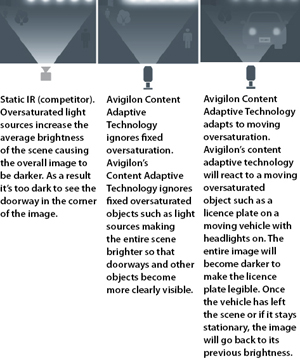
Without Avigilon’s content adaptive technology, the camera adjusts its settings based on the overall image. Areas of oversaturation will result in darker images potentially obscuring important details of moving subjects. Avigilon’s content adaptive technology ignores stationary oversaturated objects to most effectively capture both subjects moving in darker regions of the scene and licence plates on moving vehicles.
Conclusion
Avigilon’s adaptive IR technology combines zoom adaptive and content adaptive technology to capture the best evidence in any surveillance scenario. Avigilon’s zoom adaptive technology provides the most effective use of IR illumination, ensuring uniform illumination over the entire imaging area at every zoom position, and increasing IR effectiveness by focusing all the available IR to the camera’s field of view. Avigilon’s content adaptive technology smartly reduces exposure based on scene content, removing oversaturation while reducing motion blur and providing more effective licence plate illumination. Furthermore, it also ignores stationary oversaturated areas to provide the most detail of objects that are moving, even if they are in the darker regions of the image. By combining these features, Avigilon’s integrated IR cameras with their patent-pending adaptive technology provide the most effective illumination to capture the best evidence in any surveillance scenario.
For more information contact Avigilon, +27 (0)72 584 4992, [email protected], www.avigilon.com

© Technews Publishing (Pty) Ltd. | All Rights Reserved.